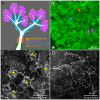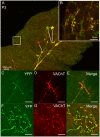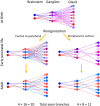Similar synapse elimination motifs at successive relays in the same efferent pathway during development in mice
- PMID: 28157072
- PMCID: PMC5315461
- DOI: 10.7554/eLife.23193
Similar synapse elimination motifs at successive relays in the same efferent pathway during development in mice
Abstract
In many parts of the nervous system, signals pass across multiple synaptic relays on their way to a destination, but little is known about how these relays form and the function they serve. To get some insight into this question we ask how the connectivity patterns are organized at two successive synaptic relays in a simple, cholinergic efferent pathway. We found that the organization at successive relays in the parasympathetic nervous system strongly resemble each other despite the different embryological origin and physiological properties of the pre- and postsynaptic cells. Additionally, we found a similar developmental synaptic pruning and elaboration strategy is used at both sites to generate their adult organizations. The striking parallels in adult innervation and developmental mechanisms at the relays argue that a general strategy is in operation. We discuss why from a functional standpoint this structural organization may amplify central signals while at the same time maintaining positional targeting.
Keywords: mouse; neuroscience; parasympathetic nerves; peripheral ganglia; synapse elimination; synaptic competition.
Conflict of interest statement
The authors declare that no competing interests exist.
Figures











Similar articles
-
Chronic 2P-STED imaging reveals high turnover of dendritic spines in the hippocampus in vivo.Elife. 2018 Jun 22;7:e34700. doi: 10.7554/eLife.34700. Elife. 2018. PMID: 29932052 Free PMC article.
-
Identification of CNS neurons with polysynaptic connections to both the sympathetic and parasympathetic innervation of the submandibular gland.Brain Struct Funct. 2015 Jul;220(4):2103-20. doi: 10.1007/s00429-014-0781-1. Epub 2014 May 3. Brain Struct Funct. 2015. PMID: 24793620
-
Synapse elimination from the mouse neuromuscular junction in vitro: a non-Hebbian activity-dependent process.J Neurobiol. 1993 Nov;24(11):1517-30. doi: 10.1002/neu.480241106. J Neurobiol. 1993. PMID: 8283186
-
Fluorescence imaging of synapse formation and remodeling.Microscopy (Oxf). 2013 Feb;62(1):51-62. doi: 10.1093/jmicro/dfs083. Epub 2012 Dec 14. Microscopy (Oxf). 2013. PMID: 23243097 Review.
-
Emerging Roles of Synapse Organizers in the Regulation of Critical Periods.Neural Plast. 2019 Sep 3;2019:1538137. doi: 10.1155/2019/1538137. eCollection 2019. Neural Plast. 2019. PMID: 31565044 Free PMC article. Review.
Cited by
-
Cell Types Promoting Goosebumps Form a Niche to Regulate Hair Follicle Stem Cells.Cell. 2020 Aug 6;182(3):578-593.e19. doi: 10.1016/j.cell.2020.06.031. Epub 2020 Jul 16. Cell. 2020. PMID: 32679029 Free PMC article.
-
Antibody deposition on vascular endothelial cells contributes to localized inflammation in salivary glands.J Oral Pathol Med. 2022 Aug;51(7):674-677. doi: 10.1111/jop.13330. Epub 2022 Jul 12. J Oral Pathol Med. 2022. PMID: 35766433 Free PMC article.
-
Molecular and functional diversity of the autonomic nervous system.Nat Rev Neurosci. 2025 Jul 3. doi: 10.1038/s41583-025-00941-2. Online ahead of print. Nat Rev Neurosci. 2025. PMID: 40610604 Review.
-
Highly localized intracellular Ca2+ signals promote optimal salivary gland fluid secretion.Elife. 2021 Jul 9;10:e66170. doi: 10.7554/eLife.66170. Elife. 2021. PMID: 34240705 Free PMC article.
-
VAST (Volume Annotation and Segmentation Tool): Efficient Manual and Semi-Automatic Labeling of Large 3D Image Stacks.Front Neural Circuits. 2018 Oct 16;12:88. doi: 10.3389/fncir.2018.00088. eCollection 2018. Front Neural Circuits. 2018. PMID: 30386216 Free PMC article.
References
-
- Brawand D, Soumillon M, Necsulea A, Julien P, Csárdi G, Harrigan P, Weier M, Liechti A, Aximu-Petri A, Kircher M, Albert FW, Zeller U, Khaitovich P, Grützner F, Bergmann S, Nielsen R, Pääbo S, Kaessmann H. The evolution of gene expression levels in mammalian organs. Nature. 2011;478:343–348. doi: 10.1038/nature10532. - DOI - PubMed
Publication types
MeSH terms
Substances
Grants and funding
LinkOut - more resources
Full Text Sources
Other Literature Sources
Molecular Biology Databases

